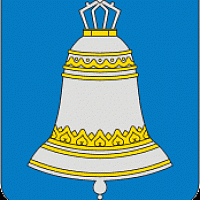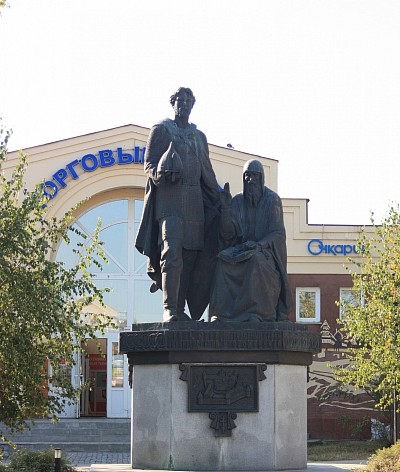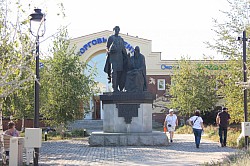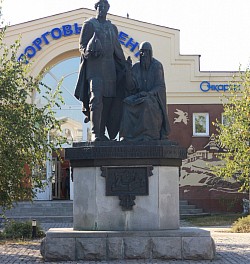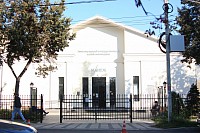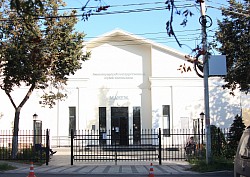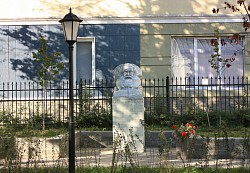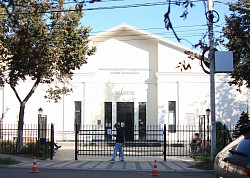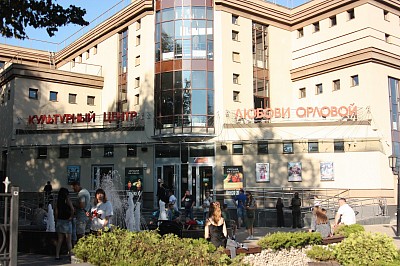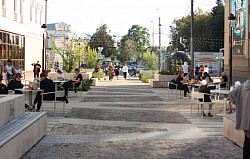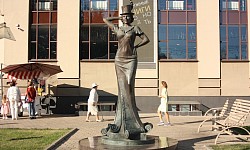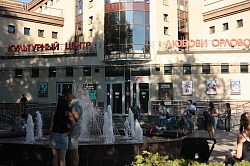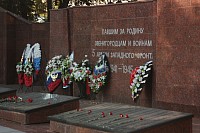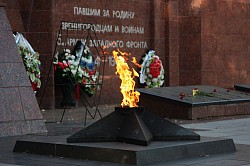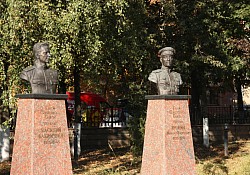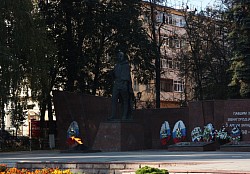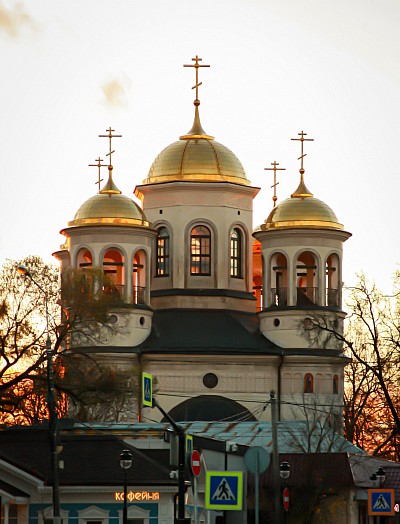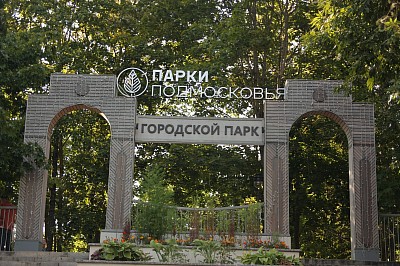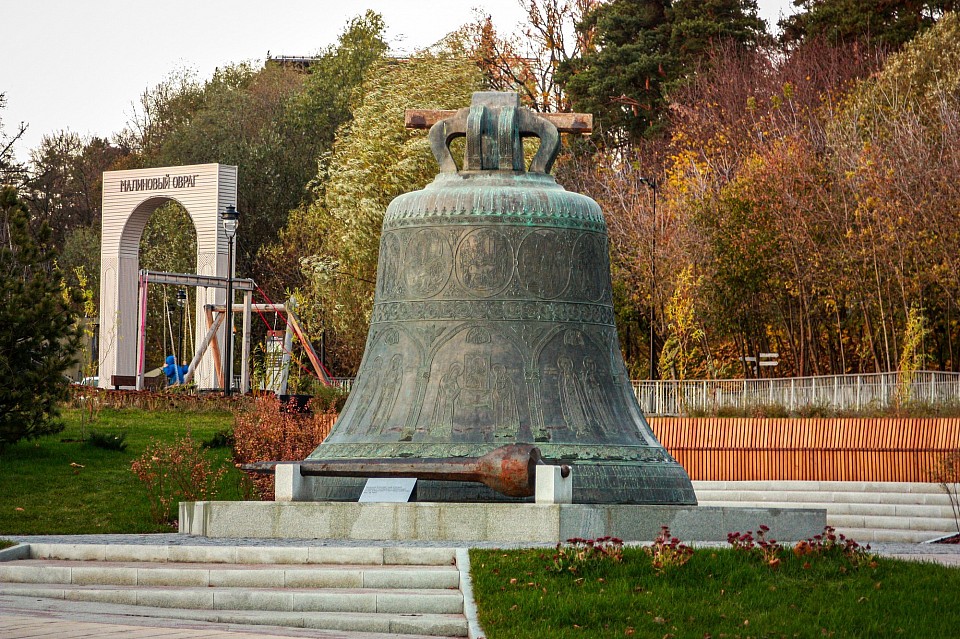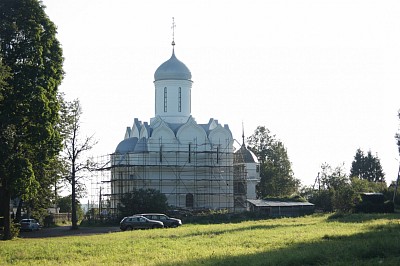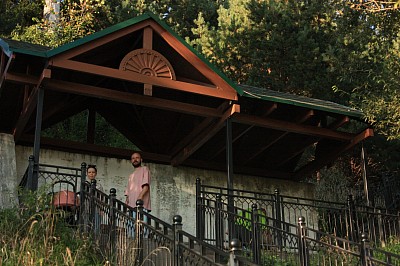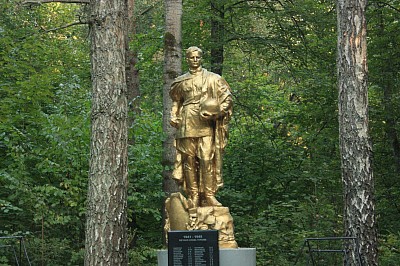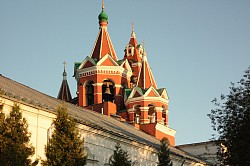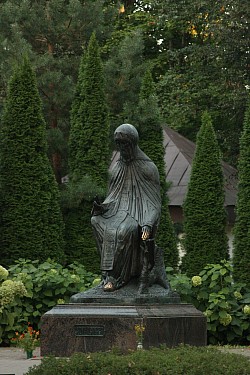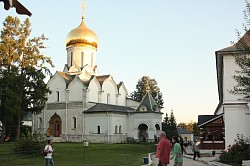Zvenigorod
Monument to St. Savva Storozhevsky and Prince Yuri of Zvenigorod.
The monument was opened on September 17, 2005 in honor of the 835th anniversary of the city. The author of the monument is the famous sculptor Andrei Kovalchuk, who depicted the figures of Prince Zvenigorod and St. Savva Storozhevsky on a high pedestal.
The marble pedestal depicts two famous heroes of the history of Zvenigorod: Prince Yuri Zvenigorodsky, son of Dmitry Donskoy, and the Monk Savva Storozhevsky, monk, founder and trustee of the Savvino-Storozhevsky Monastery.
Zvenigorod Museum-reserve "Manege".
Zvenigorod Museum-Reserve "Manege" is an exhibition complex of the Zvenigorod State Museum Reserve.
The audiovisual exhibition "From Earth to Sky" in the renovated Manege building combines traditional and modern museum experiences. The locations are filled with unique museum exhibits and engaging media content: 3D visualization of archaeological finds, animation of archival documents and works of art, three-dimensional projections on models of an ancient settlement. The set design and dramaturgy of the project prepare the viewer to immerse themselves in the story of the characters.
The Manege building is located on Moskovskaya Street— the main street of the city, which was replaced by Moskovskaya Road.
Cultural center of Lyubov Orlova.
The cultural center was created with the inspiration of architects, designers, and decorators. The building reflects the characteristic roles of Lyubov Orlova, immersing the visitor in a space where the passage of time is measured and the interiors attract the eye. The modernly equipped film center allows for international film festivals to be held in accordance with the common practice of holding such events in small towns surrounded by beautiful nature. The Center regularly screens film premieres and hosts meetings with famous actors.
Monument to Lyubov Orlova.
On September 10, 2016, the long-awaited, only in the country, monument to the legendary inimitable actress Lyubov Orlova was opened in Zvenigorod.
This monument can be called truly popular, because funds for it were raised by the whole world: city budgetary institutions of culture, education and medicine, entrepreneurs, city residents, pensioners and fans of the popular
actress.
Author of the project: Alexander Rozhnikov, Architect: Mikhail Tikhomirov.
Monument to Anton Pavlovich Chekhov.
On July 8, 2010, in honor of the 150th anniversary
of the birth of Anton Chekhov, a monument to the great writer was unveiled in Zvenigorod
.
For the first time, Chekhov performed independently as a doctor
here, in Zvenigorod. After graduating from Moscow University,
in the summer of 1884, Anton Pavlovich went to replace the doctor of the Zemsky hospital
, S. P. Uspensky. "I live in Zvenigorod and I'm getting into my
role," Anton Chekhov wrote in a letter to his brother. "I look
at myself and I feel that we can't live together, brothers! I'll
have to run away to the zemstvo aesculapius... a nice thing!" On the day, in his office
Chekhov received more than 30 patients at Zvenigorod Hospital.
The hospital building, the century-old linden tree where
Chekhov liked to sit, and the avenue of larches planted by the writer have been preserved to this day.
The author of the bronze monument is the sculptor Vladimir
Kurochkin. He depicted Chekhov sitting on a bench with a cane in his hands,
and his dog was sitting next to the writer. There was a thoughtful smile on the writer's face
, as if he had sat down on a bench during a walk.
Memorial complex to those who fell for their homeland during the Great Patriotic War.
The memorial complex is located in the very center of Zvenigorod. In fact, this is not only a memorial complex, but also a mass grave. Many residents of Zvenigorod, who fell during the The Great Patriotic War. Some of them have been identified – their names are stamped on memorial plaques. In addition, there are at least 60 people
there who could not be identified. An eternal flame has been lit in memory of all these people. There is a large sculpture of a soldier next to the eternal flame.
An inscription can be read on the wall behind the soldier's back:
Zvenigorod residents
and soldiers
of the 5th Army of the Western Front
who fell for their homeland
1941-1945
Church of the Ascension of the Lord.
Presumably, since the 16th century, a wooden Ascension Church existed in Zvenigorod. After The Troubles had the status of a patriarchal temple. In July 1790, the priest of this church Iakov Semyonov and his parish people turned to the Moscow Ecclesiastical Consistory with an "all-fervent desire" to build "a stone church again in another convenient place nearby" instead of a wooden one. The generally accepted date of the stone Ascension Church is considered to be 1792. The stone church had three chapels: the Ascension of the Lord, the Tolga Icon of the Mother of God and St. Nicholas. The bell tower was built later, in 1838, which is confirmed by the architectural features of the temple. It is located near the city park and is connected to it by a swing wrought-iron pedestrian bridge. The church hosts scheduled services, Bible and theological courses, a Sunday school for children and adults, and the Shield of Faith youth club for teenage believers.
City park.
The City Park is a cozy square located on a high hill in the city center.
The theme areas of the park reflect different aspects of Zvenigorod's life and create a sense of intimacy among visitors, characteristic of the city. The park has children's elements, ping-pong tables, benches under the shade of trees and outdoor verandas.
Unexpected architectural solutions have been implemented in the City Park: paving with "artifacts", carvings in the form of a secret inscription of the Zvenigorod bell on the lampshade above the area with chess tables, an amphitheater with a bas-relief in the form of ornaments of the Assumption Cathedral, bells on trees.
During the holidays, the park hosts entertainment programs for adults and children.
The stump of the Chekhov linden tree.
The stump of the Chekhov linden tree is located in Zvenigorod on Oktyabrskaya Street. This is the former linden tree, under which Anton Pavlovich Chekhov, who worked as a doctor at the Zvenigorod County Zemstvo hospital in the summer of 1884, liked to relax.
The linden tree became a stump in 2013, when it suffered from strong winds and snowfall. Now there is a solid stump in place of the tree, decorated with a memorial plaque.
Around the stump of Chekhov's lime tree there is a small square with benches and slabs on which quotations from Chekhov's works are written. There is also a walking route along the Raspberry Ravine nearby.
Temple on the Gorodok.
Zvenigorodsky town is located on a small hill, on the town stands the white—stone Cathedral of the Assumption. Presumably, it stood here
in 1399, and only those very ramparts with pine trees are older than it. From the cathedral, you can observe a gentle slope that turns into a steep hill, which in turn leads to the riverbed. Moscow rivers. This was how Zvenigorodsky Gorodok defended itself from attacks at the time.
The defense of Zvenigorodsky Gorodok was wisely arranged: two earthen ramparts 8 meters high. The outer side consisted of clay and ran at an angle
of 70 degrees. It was only necessary to splash water on this shaft,
and the rampart immediately became impregnable, as the enemies simply
could not climb on the slippery surface.
Nowadays, various holidays are held there, reconstructions
are being made, and ancient traditions are being recalled.
The source is on the Gorodok.
The spring has been known since ancient times. Locals and visitors collect water for drinking here, sometimes in large quantities (hundreds of liters). There are long queues.
The composition of the healing water: magnesium-calcium sulfate, used for drinking treatment.
The springs are beating from different sides of the Town. For example, you can draw water from the opposite side of the slide, opposite the stream and the most picturesque pines.
Memorial of the Great Patriotic War "Bronze Warrior".
The Bronze Warrior Memorial of the Great Patriotic War is located in Zvenigorod, not far from the Savvino-Storozhevsky Monastery. It is located on the site of a mass grave. On the pedestal there is a sculpture with a helmet in his hands. At his feet is a monument with a list of fallen soldiers.
How to get there: if you walk from Zvenigorod settlement to the monastery, you need to turn off the road for a while. There is a road sign on the site of the memorial, as well as a small path.
Savvino-Storozhevsky Monastery.
Savvino-Storozhevsky Monastery is an Orthodox Stavropol monastery in the city of Zvenigorod, Moscow region. Founded at the end of the 14th century, it is located on Storozhi Mountain at the confluence of the Storozhka River with the Moskva River.
Some historical facts:
The monastery was founded by monk Savva, a disciple of St. Sergius of Radonezh, at the request and with the support of Prince Yuri Dmitrievich of Zvenigorod.
In the XV–XVII centuries, the Savvino-Storozhevsky Monastery played the role of an outpost of the Moscow Principality in the west.
Under Tsar Alexei Mikhailovich, the monastery became a country royal residence. The empress's palace and royal chambers were built here.
After the revolution, the Savvino-Storozhevsky Monastery was closed, and its valuables were taken away or looted. The monastery's revival began in 1995 and continues to this day.
The main temple of the monastery is the Cathedral of the Nativity of the Virgin, built in the early 15th century on the site of an old wooden church. Address: Moscow region, Zvenigorod, Savvino-Storozhevsky monastery.
